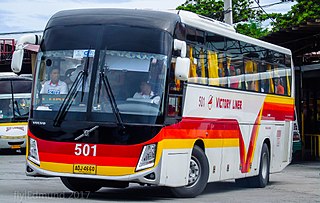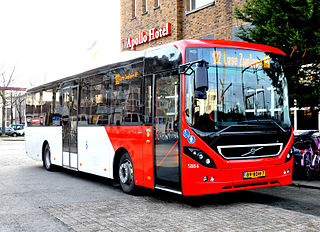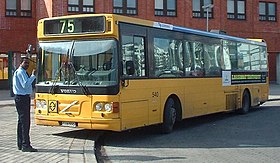
Volvo Buses, stylized as VOLVO, is a subsidiary and a business area of the Swedish vehicle maker Volvo, which became an independent division in 1968. It is based in Gothenburg.

The Volvo B9TL is a low-floor double-decker bus built by Volvo from 2002 until 2018. It superseded the Volvo Super Olympian and the Volvo B7TL. The 2-axle version has been superseded by the Volvo B5TL in 2014 and the 3-axle version has been superseded by the Volvo B8L in 2018.

Volgren is an Australian bus and coach body manufacturer.

The Volvo B7RLE is a low-entry single-deck bus chassis manufactured by Volvo. It was superseded by the Volvo B8RLE in 2013.

The Volvo B7R is a coach chassis available with a range of bodies. It is promoted as a rear engined lightweight coach chassis. It is primarily intended for tourist and long-distance duties. B7R is also manufactured in China, Brazil, Hungary, India and Iran for use in regional transport services.

The Volvo B7L is a fully low floor single-decker bus, double-decker bus and articulated bus chassis with a rear engine mounted vertically on the left of the rear overhang. It was built as a replacement for the Volvo B10L, and the Volvo Olympian. It was used as both a single-decker bus and a double-decker bus chassis largely in Continental Europe.

The Volvo B12BLE is a low-entry city and suburban bus chassis launched in 2001 with a rear-mounted transverse engine. It superseded the Volvo B10BLE and is used as a base for single-decker buses in Europe and Australia.

The Volvo B10M is a mid-engined city bus and coach chassis manufactured by Volvo between 1978 and 2003. It succeeded the B58 and was equipped with the same 9.6-litre horizontally mounted Volvo diesel engine mounted under the floor behind the front axle. An articulated version under the model name Volvo B10MA was also offered, as was a semi-integral version known as the C10M, with the engine in the middle of the chassis.

The Mercedes-Benz OC 500 LE is a modular, heavy-duty, twin-axle bus chassis produced by Mercedes-Benz/EvoBus Ibérica, Spain. It was designed as a modular platform for low-entry city, suburban, and intercity buses with a maximum gross vehicle weight of 19.1 tonnes. The main modules consist of: driver's pedestal, front axle, buggy centre section, drive axle and engine. It has much in common with the chassis used for the Mercedes-Benz Citaro integral bus range, and also the raised floor OC 500 RF coach chassis. The engine is horizontally mounted over the rear overhang.

The Mercedes-Benz O405 is a single-decker bus manufactured by Mercedes-Benz from the mid-1980s to the early 2000s as either an integral bus or a bus chassis; it was the last VöV SL-II standard bus in production. It replaced the O305 and was widely used in Europe, the United Kingdom, Australia and Singapore with 12,000 produced.

The Volvo B10L was a rear-engined, low-floor single-decker public bus chassis built by Volvo between c. 1993 and c. 2005. An articulated version of the B10L, known as the B10LA, was also produced.

The Wright Eclipse is a low-floor single-deck bus body that was built by Wrightbus between 1999 and 2019. The second-generation Eclipse 2 was launched in 2008, followed by the third-generation Eclipse 3 in 2015. The Eclipse, and its sister design the Solar, were named for a solar eclipse which was visible in the UK in 1999, the year of its introduction.

The Scania 4-series low floor city bus and coach range was introduced by Scania in 1997 as a successor to the 3-series bus range.

The MAN Lion's City is a range of low-floor and low-entry public buses built by German truck and bus manufacturer MAN Truck & Bus since 1996 primarily for the European market, but is also available in chassis-only variants worldwide. The name Lion's City has been used since 2006, when MAN's public bus models which had been marketed separately were gathered into one range, when also most models received a facelift. The first models to be introduced were the 12-metre low-floor intercity bus NÜ xx3 (A20) in 1996, the 12-metre city bus NL xx3 (A21) in 1997 and the articulated NG xx3 (A23) in 1998. As with former MAN bus models the power-rating made up part of the model name, giving the NÜ-series buses with power-ratings of 260 and 310 hp model names NÜ 263 and NÜ 313 respectively. The main production sites are in Starachowice and Sady in Poland, but the models have also been built in Germany, Turkey and Malaysia. Initially most of the midibus variants were manufactured by Göppel Bus in Augsburg, later Nobitz.

A single-decker bus or single-decker is a bus that has a single deck for passengers. Normally the use of the term single-decker refers to a standard two-axled rigid bus, in direct contrast to the use of the term double-decker bus, which is essentially a bus with two passenger decks and a staircase. These types of single-deckers may feature one or more doors, and varying internal combustion engine positions. The majority of single-deckers have a length of up to 12 metres, although some exceptions of longer buses exist. They also typically weigh between 11 and 14 tons.

The Volvo B5LH is a low-floor hybrid electric bus chassis for both single-decker buses and double-decker buses manufactured by Volvo between 2008 and 2023. It is the basis for Volvo's integral 7700 Hybrid full low floor city bus and its successor, the 7900 Hybrid from 2011. In 2008, pre-production batches of both types of chassis were manufactured. Serial production started in June 2010. From 2013 it is also available as an articulated bus chassis. First entering service in London, the B5LH is the only current double decker type in service in the United Kingdom that uses a parallel hybrid drive system.

The Volvo B10B was a rear-engined step deck single-decker bus chassis manufactured by Volvo between 1992 and 2001. The first prototype were built in 1990, but the B10B wasn't launched until the 1992 Geneva Motor Show. It superseded the Leyland Lynx and Volvo B10R. For stage use it was gradually succeeded by the low-entry B10BLE, which was introduced only a year later, though not in all markets. For interurban use the B7R came as a gradual replacement in 1998, and ultimately for coach work, the B12B took over in 2001.
The Volvo B10 was a front-engined bus chassis built in the 1930s, but may also refer to different 9.6-litre engined bus chassis from Volvo Buses:

The Volvo B9L is a fully low-floor single-decker bus chassis constructed by Volvo Buses from 2005 until 2013, replacing the Volvo B7L and Volvo B10L. An articulated model, known as the Volvo B9LA, is also available. It was superseded by the Volvo B5LH in Europe.

The Volvo B8RLE is a 7.7-litre-engined low-entry bus chassis manufactured by Volvo since 2013 for left-hand drive markets. It was designed as a replacement for the B7RLE and the B9RLE. The right-hand drive version was launched in November 2014.






















